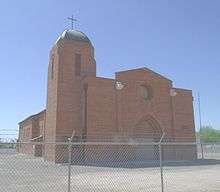Sacred Heart Church (Phoenix, Arizona)

Sacred Heart Church, or the Historic Sacred Heart Church, is an unoccupied church located at 16th St and Buckeye Roads, which was placed on the National Register of Historic Places by the US Department of Interior with the efforts of the Braun Sacred Heart Center Inc. in 2012.[1] The lot the Sacred Heart Church sits on is owned by the City of Phoenix, Aviation Department.[2] Sacred Heart Church was the pillar of the Golden Gate Barrio, and the Braun Sacred Heart Center Inc. has been hosting a yearly Christmas Day Mass at noon for former residents since 1986, with the permission of the City of Phoenix.[3]
History
Around 1950, Victor Stinger donated a small lot at 17th and Sherman Streets in Phoenix, AZ to be used for Catholic mass for the residents of the Golden Gate Barrio and its surrounding barrios.[4] The original structure was a ramada with a dirt floor and a palm thatch roof.[5]
The construction of Sacred Heart Church is credited to Albert Braun. Around 1952, Father Al, as he was known, began working within the community and requested that he remain in the barrios and not be moved around like "all the others" until he "completed his work".[6] Father Al held his first mass under the ramada on August 10, 1952 and held mass there for two and one half years.[7]
During this two and one half year period, Father Al began acquiring land through political activism and brick through a local fundraising campaign within the Golden Gate Barrio whereas every single resident, including children, would each buy at least one red brick after the supply of adobe bricks was destroyed in a rain storm. With an $8,000 loan from the Bishop of Tucson, the rectory was completed on March 15, 1954.[8] Two chapels were constructed on the southern and eastern sections of the parish: Saint Isabel (later named Saint John's) on 18th St. and Magnolia and Saint Mary Magdalene on 11th St. and Hilton with first mass dates being on March 18, 1954 and May 17, 1954, respectively.[9] The altar, made of Italian marble, the roof, bell tower, and copper dome were added shortly after, completing construction. Father Al left the parish in 1962, but remain involved in the church at various capacities until his death in 1983.
The Dioceses of Phoenix sold the Church to the City of Phoenix, Aviation Department in 1985 through the West Approach Land Acquisition Project.
Cultural & Historical Significance
Although Sacred Heart Parish was one of the poorest parishes during its active tenure, Father Al committed the church to the community by having its two most active parishioners, Ramon Arvizu and Pete Avila, graduate from St. Vincent De Paul Society's charity training school to help the local residents with food insecurity and inadequate housing.[10] Ramon Arvizu was the father of the late Abraham F. Arvizu, a pioneering community activist from Phoenix, AZ. Abraham J. Arvizu, son of Abraham F. Arvizu, is one of the last surviving members of the Sacred Heart Church Parish Council.
Understanding the importance of community cohesion, Father Al and his parishioners continued to address non-religious needs such as lighting, pavements, and sewage systems. A local juvenile court worker stated that after Father Al's arrival, "the number of juvenile cases dropped sharply as those persons under his influence began working together as family units and as a community".[11]
Historically, the site is the last remaining structure from the Golden Gate Barrio. The Golden Gate Barrio and its nearly 6,000 residents were eventually forced out of their homes under eminent domain through the West Approach Land Acquisition Project in the 1970s and 1980s.[12]
References
- ↑ "Historic Plaque Ceremony".
- ↑ "Inventory".
- ↑ "State of Change Arizona Now: Sacred Heart Church". cronkitezine.asu.edu.
- ↑ Dimas, Pete (1999). Progress and a Mexican American Community's Struggle for Existence: Phoenix's Golden Gate Barrio. New York: Peter Lang Publishing. p. 68. ISBN 0-8204-2353-X.
- ↑ Sherman, Barbara (1981). History of the Sacred Heart Church in Golden Gate Barrio.
- ↑ Dimas, Pete (1999). Progress and a Mexican American Community's Struggle for Existence: Phoenix's Golden Gate Barrio. New York: Peter Lang Publishing. p. 73. ISBN 0-8204-2353-X.
- ↑ Dimas, Pete (1999). Progress and a Mexican American Community's Struggle for Existence: Phoenix's Golden Gate Barrio. New York: Peter Lang Publishing. p. 74. ISBN 0-8204-2353-X.
- ↑ Dimas, Pete (1999). Progress and a Mexican American Community's Struggle for Existence: Phoenix's Golden Gate Barrio. New York: Peter Lang Publishing. p. 75. ISBN 0-8204-2353-X.
- ↑ Dimas, Pete (1999). Progress and a Mexican American Community's Struggle for Existence: Phoenix's Golden Gate Barrio. New York: Peter Lang Publishing. p. 75. ISBN 0-8204-2353-X.
- ↑ Dimas, Pete (1999). Progress and a Mexican American Community's Struggle for Existence: Phoenix's Golden Gate Barrio. New York: Peter Lang Publishing. p. 77. ISBN 0-8204-2353-X.
- ↑ Emerson, Dorothy (1973). Among the Mescalero Apaches: The Story of Father Albert Braun, O.F.M. The University of Arizona Press.
- ↑ Dimas, Pete (1999). Progress and a Mexican American Community's Struggle for Existence: Phoenix's Golden Gate Barrio. New York: Peter Lang Publishing. p. 93. ISBN 0-8204-2353-X.